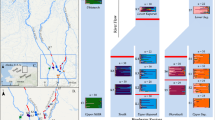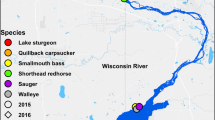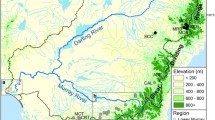Abstract
The genetic structure of a stream-dwelling fish, the Greenside Darter, Etheostoma blennioides, is described from variation at nine microsatellite loci in 26 populations in the northern-most portions of the species’ range in southern Ontario, Canada in two sampling years. We found relatively high levels of genetic structure at the among- and within-watershed scales, with some watersheds and populations exhibiting very high divergence. The Ausable River populations were especially isolated, containing distinct populations of potential conservation concern. Temporal replicates at selected localities showed evidence of substantial temporal variation in genetic structure, perhaps resulting from movement among sites. We found strong evidence for an effect of river barriers (dams and weirs) on dispersal measured by genotype assignment techniques. However, we found no bias in upstream vs downstream dispersal. Significant isolation-by-distance relationships in both sample years indicate that river distance is an important factor regulating gene flow in these watersheds. The Canadian Greenside Darter populations are expanding their range into more northerly watersheds, but also show substantial within-watershed genetic structure despite substantial dispersal.





Similar content being viewed by others
References
Angers B, Bernatchez L (1998) Combined use of SMM and non-SMM methods to infer fine structure and evolutionary history of closely related Brook Charr (Salvelinus fontinalis, Salmonidae) populations from microsatellites. Mol Biol Evol 15:143–159
Arnell NW, Reynard NS (1996) The effects of climate change due to global warming on river flows in Great Britain. Hydrology 183:397–424. doi:10.1016/0022-1694(95)02950-8
Beneteau CL, Mandrak NE, Heath DD (2007) Characterization of eight polymorphic microsatellite DNA markers for the Greenside Darter, Etheostoma blennioides (Percidae). Mol Ecol Notes 7:641–643. doi:10.1111/j.1471-8286.2006.01661.x
Bouzat JL, Johnson K (2004) Genetic structure among closely spaced leks in a peripheral population of lesser prairie chickens. Mol Ecol 13:499–505. doi:10.1046/j.1365-294X.2003.02068.x
Bunnell FL, Campbell RW, Squires KA (2004) Conservation priorities for peripheral species: the example of British Columbia. Can J Res 34:2240–2247. doi:10.1139/x04-102
Bunt CM, Cooke SJ, McKinley RS (1998) Creation and maintenance of habitat downstream from a weir for the Greenside Darter, Etheostoma blennioides – a rare fish in Canada. Environ Biol Fishes 51:297–308. doi:10.1023/A:1007444811400
Cavalli-Sforza LL, Edwards AWF (1967) Phylogenetic analysis: models and estimation procedures. Evol Int J Org Evol 21:550–570. doi:10.2307/2406616
Cunjack RA (1988) Physiological consequences of over-wintering in streams: the cost of acclimatization. Can J Fish Aquat Sci 45:443–452
Dalton KW (1991) Status of the Greenside Darter, Etheostoma blennioides, in Canada. Can Field Nat 105:173–178
Elphinstone MS, Hinten GN, Anderson MJ, Nock CJ (2003) An inexpensive and high-throughput procedure to extract and purify total genomic DNA for population studies. Mol Ecol Notes 3:317–320. doi:10.1046/j.1471-8286.2003.00397.x
Faber JE, White MM (2000) Comparison of gene flow estimates between species of darters in different streams. J Fish Biol 57:1465–1473. doi:10.1111/j.1095-8649.2000.tb02225.x
Fahrig L, Merriam G (1994) Conservation of fragmented populations. Conserv Biol 8:50–59. doi:10.1046/j.1523-1739.1994.08010050.x
Fraser DF (2000) Species at the edge: the case for listing of “peripheral” species. In: Darling LM (ed) Proceedings of a conference on the biology and management of species and habitats at risk, Kamloops, 1999
Goudet J (2001) fstat, a program to estimate and test gene diversities and fixation indices (version 2.9.3). Department of Ecology & Evolution, University of Lausanne, Switzerland. See http://www2.unil.ch/popgen/softwares/fstat.htm. Accessed 30 Nov 2007
Heithaus MR, Laushman RH (1997) Genetic variation and conservation of stream fishes: influence of ecology, life history, and water quality. Can J Fish Aquat Sci 54:1822–1836. doi:10.1139/cjfas-54-8-1822
Hoffman AA, Blows MW (1994) Species borders: ecological and evolutionary perspectives. Trends Ecol Evol 9:223–227. doi:10.1016/0169-5347(94)90248-8
Hunter ML Jr (1991) Coping with ignorance: the coarse-filter strategy for maintaining biodiversity. In: Holm K (ed) Balancing on the brink of extinction: the Endangered Species Act and lessons for the future. Island Press, Washington, DC
Hutchinson DW (2003) Testing the central/peripheral model: analyses of microsatellite variability in the eastern collared lizard (Crotaphytus collaris collaris). Am Midl Nat 149:148–162. doi:10.1674/0003-0031(2003)149[0148:TTCPMA]2.0.CO;2
Kyle CJ, Strobeck C (2002) Connectivity of peripheral and core populations of North American wolverines. J Mammol 83:1141–1150. doi :10.1644/1545-1542(2002)083<1141:COPACP>2.0.CO;2
Labbe TR, Fausch KD (2000) Dynamics of intermittent stream habitat regulate persistence of a threatened fish at multiple scales. Ecol Appl 10:1774–1791. doi:10.1890/1051-0761(2000)010[1774:DOISHR]2.0.CO;2
Lammi A, Siikamäki P, Mustajärvi (1999) Genetic diversity, population size, and fitness in central and peripheral populations of a rare plant Lychnis viscaria. Conserv Biol 13:1069–1078. doi:10.1046/j.1523-1739.1999.98278.x
Langella O (2002) populations 1.2.28. Logiciel de genetique des populations. Laboratoire Populations, genetique et evolution, CNRS UPR 9034, Gif-sur-Yvette, http://www.cnrs-gif.fr/pge/
Lesica P, Allendorf FW (1995) When are peripheral populations valuable for conservation? Conserv Biol 9:753–760. doi:10.1046/j.1523-1739.1995.09040753.x
Magnuson JJ, Webster KE, Assel RA et al (1997) Potential effects of climate change on aquatic systems: Laurentian Great Lakes and Precambrian shield region. Hydrol Process 11:825–871. doi :10.1002/(SICI)1099-1085(19970630)11:8<825::AID-HYP509>3.0.CO;2-G
Mandrak NE, Crossman EJ (1992) Postglacial dispersal of freshwater fishes in Ontario. Can J Zool 70:2247–2259
Miller MP (1997) Tools for population genetic analyses (tfpga): a Windows program for the analysis of allozyme and molecular population genetic data v.1.3, February 2000. Available via http://bioweb.usu.edu/mpmbio. Accessed 30 Nov 2007
Page RDM (2001) treeview (Win32) v. 5. URL: http://taxonomy.zoology.gla.ac.uk/rod/rod.html. Accessed 30 Nov 2007
Peakall R, Smouse PE (2006) genalex 6: genetic analysis in Excel. Population genetic software for teaching and research. Mol Ecol Notes 6:288–295. doi:10.1111/j.1471-8286.2005.01155.x
Piry S, Alapetite A, Cornuet JM et al (2004) geneclass 2: a software for genetic assignment and first generation migrants detection. J Hered 95:536–539. doi:10.1093/jhered/esh074
Quinn JF, Karr JR (1993) Habitat fragmentation and global change. In: Kareiva PM, Kingsolver JG, Huey RB (eds) Biotic interactions and global change. Sinauer and Associates, Massachusetts, pp 451–463
Rannala B, Mountain JL (1997) Detecting immigration by using multilocus genotypes. Proc Natl Acad Sci USA 94:9197–9201. doi:10.1073/pnas.94.17.9197
Raymond M, Rousset F (1995) An exact test for populations differentiation. Evol Int J Org Evol 49:1280–1283. doi:10.2307/2410454
Ricciardi A (2003) Predicting the impacts of an introduced species from its invasion history: an empirical approach applied to zebra mussel invasions. Freshw Biol 48:972–981. doi:10.1046/j.1365-2427.2003.01071.x
Schlosser IJ, Toth LA (1984) Niche relationships and population ecology of rainbow (Etheostoma caeruleum) and fantail (E. flabellare) darters in a temporally variable environment. Oikos 42:229–238. doi:10.2307/3544798
Schneider S, Roessli D, Excoffier L (2000) arlequin v. 3.0. Genetics and Biometry Laboratory, University of Geneva, Switzerland
Scott WB, Crossman EJ (1973) Freshwater fishes of Canada. Bull Fish Res Board Can 184: 966 pp
Tonnis BD (2006) Microsatellite DNA markers for the rainbow darter, Etheostoma caeruleum (Percidae), and their potential utility for other darter species. Mol Ecol Notes 6:230–232. doi:10.1111/j.1471-8286.2005.01203.x
Turner TF (2001) Comparative study of larval transport and gene flow in darters. Copeia 2001:766–774. doi:10.1643/0045-8511(2001)001[0766:CSOLTA]2.0.CO;2
Turner TE, Trexler JC (1998) Ecological and historical associations of gene flow in darters (Teleostei: percidae). Evol Int J Org Evol 52:1781–1801. doi:10.2307/2411349
Van Oosterhout C, Hutchinson WF, Wills DPM, Shipley P (2004) Micro-checker: software for identifying and correcting genotyping errors in microsatellite data. Mol Ecol Notes 4:535–538. doi:10.1111/j.1471-8286.2004.00684.x
Weir BS, Cockerham CC (1984) Estimating F-statistics for the analysis of population structure. Evol Int J Org Evol 38:1358–1370. doi:10.2307/2408641
Winn HE (1958) Comparative reproductive behavior and ecology of fourteen species of darters (Pisces-Percidae). Ecol Monogr 28:155–191. doi:10.2307/1942207
Acknowledgements
This work was supported by funding from the Species at Risk program of the Department of Fisheries and Oceans, Canada, and Natural Sciences and Engineering Research Council, Canada funding to DDH. Thank you to Ryan Walter for helpful discussions and manuscript review. Special thanks also to Bradley Dufour and David Marson (DFO) for assistance in sample collection. We also acknowledge an anonymous reviewer for their constructive comments of on an earlier version of the manuscript.
Author information
Authors and Affiliations
Corresponding author
Rights and permissions
About this article
Cite this article
Beneteau, C.L., Mandrak, N.E. & Heath, D.D. The effects of river barriers and range expansion of the population genetic structure and stability in Greenside Darter (Etheostoma blennioides) populations. Conserv Genet 10, 477–487 (2009). https://doi.org/10.1007/s10592-008-9627-9
Received:
Accepted:
Published:
Issue Date:
DOI: https://doi.org/10.1007/s10592-008-9627-9




